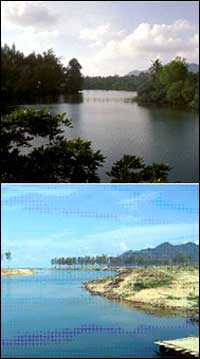Lessons from the tsunami: protect the coast and it will protect you

Photograph of a lagoon in Banda Aceh, Indonesia, pre and post tsunami of December, 2004
Coastal populations and ecosystems are more likely to bounce back from extreme coastal disasters by protecting local environments and building on local knowledge, according to a report published in Science today.
And the aftermath of the Asian tsunami has given valuable insight into handling extreme coastal disasters – inevitable as the world’s coastal population is set to double by 2030 and global warming continues to exacerbate extreme weather conditions.
The research team from Australia, US, Sweden and UK, led by Dr Neil Adger of the University of East Anglia, is calling for action that builds on the existing resilience of coastal environments and communities when setting up disaster management policies to cope with cyclones, hurricanes, tsunamis and floods.
The Social-Ecological Resilience to Coastal Disasters report concludes that healthy ecosystems are much more likely to absorb the shock and provide protection from a coastal disaster than man-made structures such as sea walls or artificial reefs.
Globally 23 per cent of the world’s population (1.2 billion people) live within 100 km of the coast and this figure is likely to increase to 50 per cent in the next twenty five years as people flock to coastal cities – many these being Asian cities.
To compound this, many weather-related disasters are becoming more destructive and intense due to climate change.
The report is based on two case studies – the Asian tsunami in 2004 and the impact of severe storms in the Caribbean over the past twenty years.
The tsunami had less impact in areas where ecosystems were protected and local communities were aware of coastal hazards than those places where development went right up to the coastline.
Sand dunes, mangrove forests and coral reefs helped reduce the energy of tsunami waves in Sri Lanka by acting as natural barriers, the Stockholm Environment Institute discovered in a rapid assessment of the environmental impact of the tsunami.
In the Caribbean, the Cayman Islands have adapted to major hurricanes. The government took positive action and educated communities following two major hurricanes in 1988 and 1998 and were much more able to adapt, cope and recover from Hurricane Ivan in 2004.
Traditional farming systems which integrated coffee with maize in Honduras were much better at recovering from Hurricane Mitch in 1998 than farming systems which solely grew coffee.
Dr Adger, of the Tyndall Centre at UEA, argues that maintaining resilience is the key. New scientific insights from ecologists show that natural ecosystems such as coral reefs and coastal mangrove forests can adapt to change and recover from storms and floods and still provide services of protecting the coast and absorbing pollution. But once these ecosystems are put under pressure by coastal development, they may lose their resilience.
Similarly, if communities are more resilient they are going to be able to learn from past experience and to deal with disasters better and to recover quickly.
Dr Neil Adger co author of the report said: “If we protect our coastal environment, it will protect us in times of disaster. This now appears to be true for some areas of Asia affected by the tsunami. And it will certainly be true for coasts of the future.”
Media Contact
More Information:
http://www.uea.ac.ukAll latest news from the category: Ecology, The Environment and Conservation
This complex theme deals primarily with interactions between organisms and the environmental factors that impact them, but to a greater extent between individual inanimate environmental factors.
innovations-report offers informative reports and articles on topics such as climate protection, landscape conservation, ecological systems, wildlife and nature parks and ecosystem efficiency and balance.
Newest articles

Properties of new materials for microchips
… can now be measured well. Reseachers of Delft University of Technology demonstrated measuring performance properties of ultrathin silicon membranes. Making ever smaller and more powerful chips requires new ultrathin…

Floating solar’s potential
… to support sustainable development by addressing climate, water, and energy goals holistically. A new study published this week in Nature Energy raises the potential for floating solar photovoltaics (FPV)…

Skyrmions move at record speeds
… a step towards the computing of the future. An international research team led by scientists from the CNRS1 has discovered that the magnetic nanobubbles2 known as skyrmions can be…





















